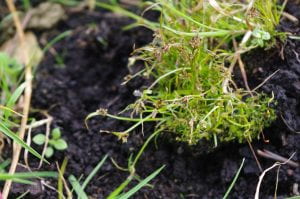
One of Britain’s rarest plants the Brown Galingale, Cyperus fuscus is to be replanted back into one of its UK strongholds from plants grown at the Botanic Garden. The Brown Galingale is part of the Southern-temperate element of the Eurosiberian Flora and is found all over Europe, parts of Asia as far East as China and Thailand. It is absent from Ireland. In the UK it is confined to a handful of sites Southern England where historically it has been recorded in 11 x 10km squares. Today it is only found in six of these sites: North Somerset, South Hampshire, Berkshire, Buckinghamshire and Surry.
It prefers disturbed ground, field margins and ditch edges, particularly where the cattle poach the wet earth. It grows on peaty soils, muddy and stony soils, but always where there is a high level of organic matter. Locally it grows in the Gordano Valley National Nature Reserve where is behaves as a summer annual germinating as the water table drops and the wet earth at ditch margins are exposed to the suns warmth. We have grown this plant before at the Botanic Garden previous home Bracken Hill in Leigh Woods, where it flourished in the cool end of the propagation glasshouse. From this information we have sown seeds in number of locations within the glasshouses and nursery.

Last year plants germinated and developed well in pots before seeding. Seed was collected and sent to the Millennium Seed Bank at Wakehurst Place for long term storage. Earlier this year Penny Harms Glasshouse Coordinator, sowed seed in a number of trays outside and placed the old pots from last year’s plants outside the glasshouse. The result have been a mass germination. In some trays there are thousands of individual plants and many seedlings are developing in the old pots used last year.
Plants are currently being grown on before planting out in a number of prepared sites in the Gordano National Nature Reserve. In the UK this species is classed as Vulnerable.

